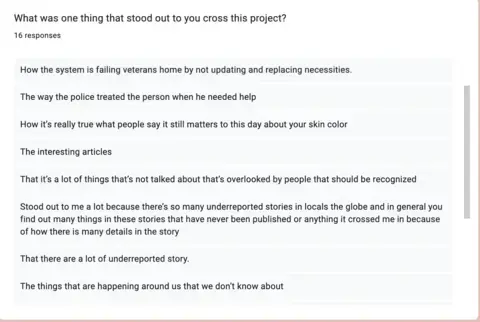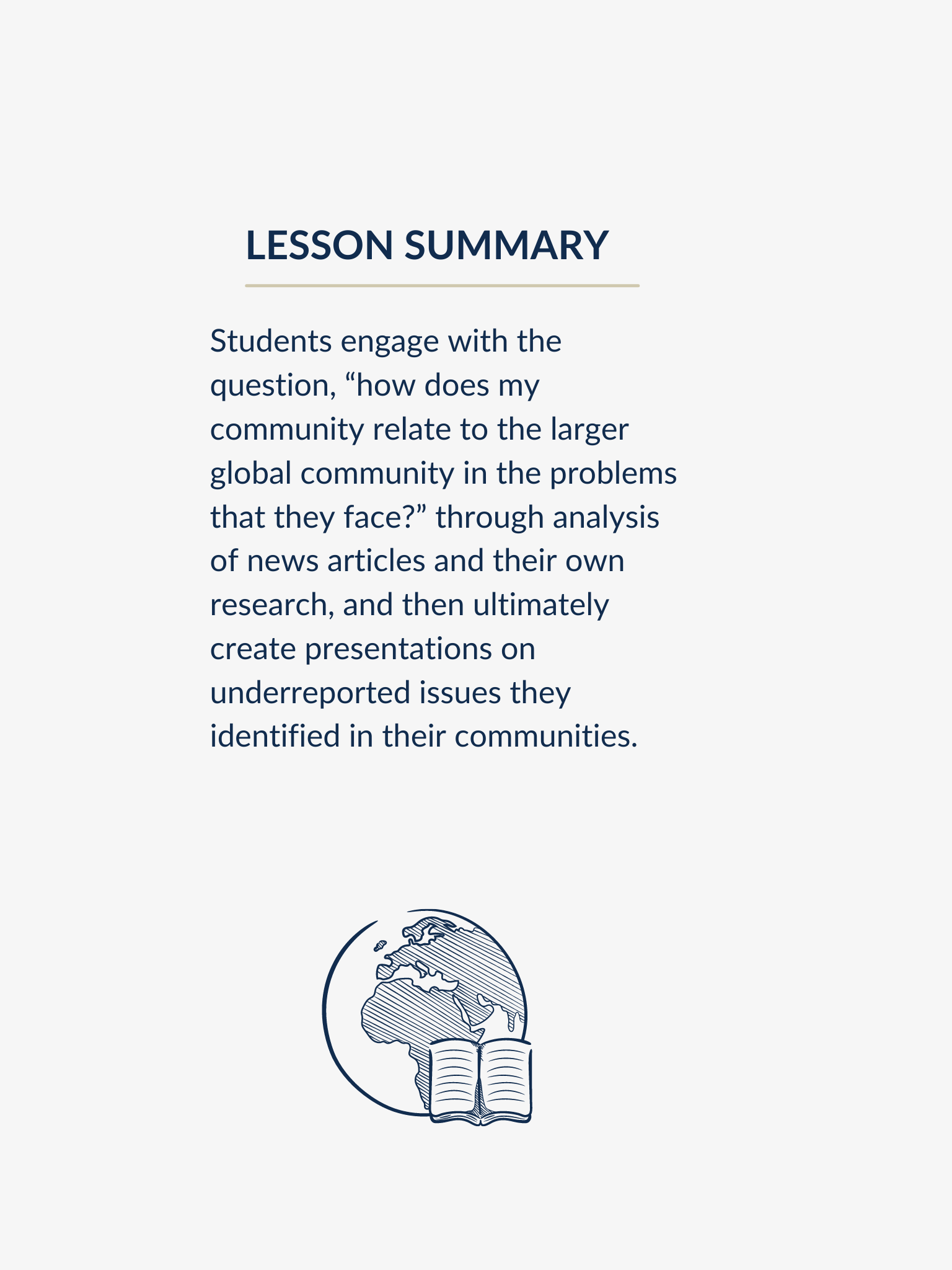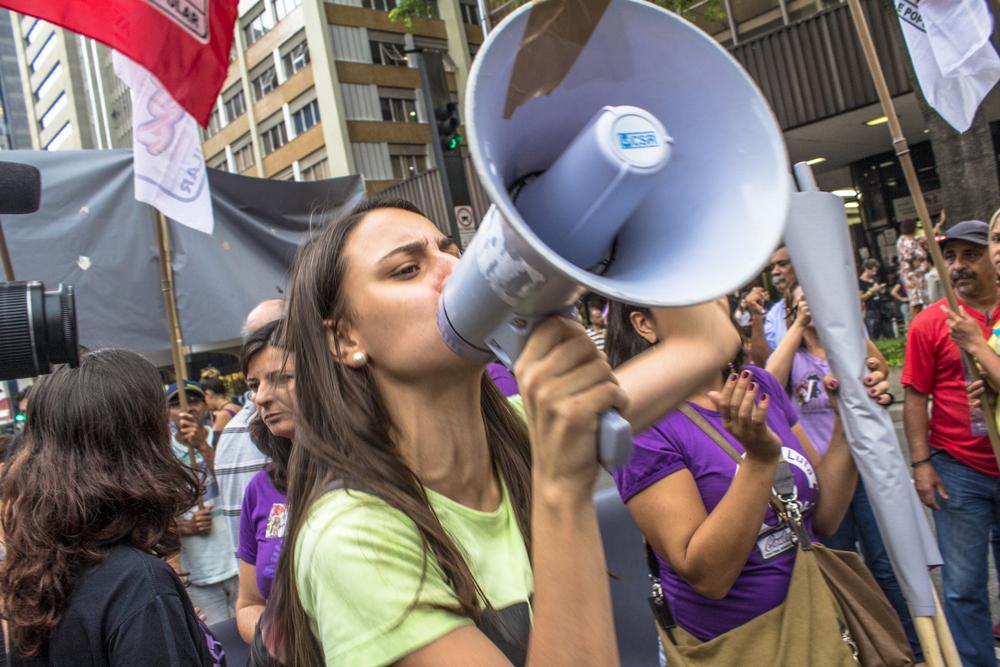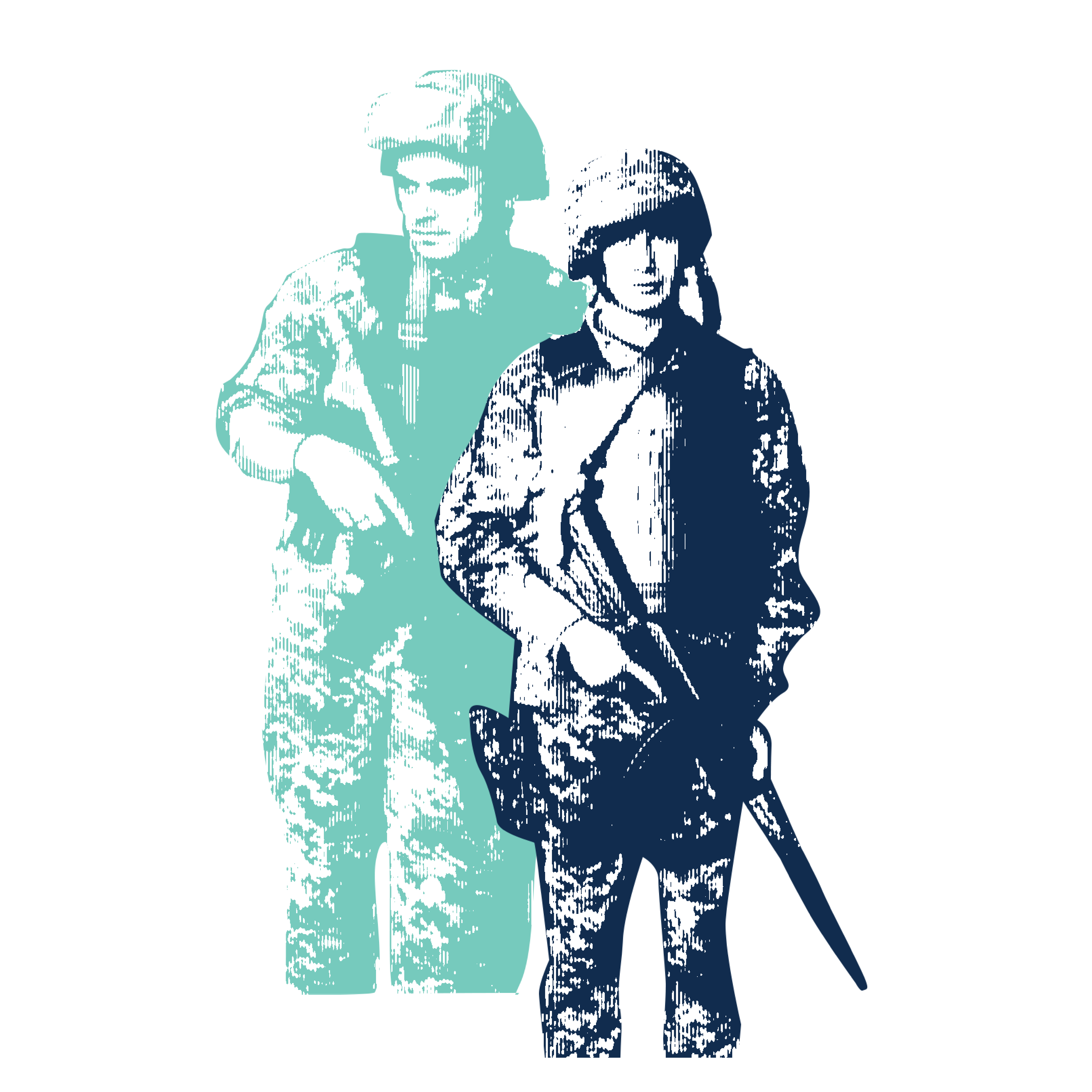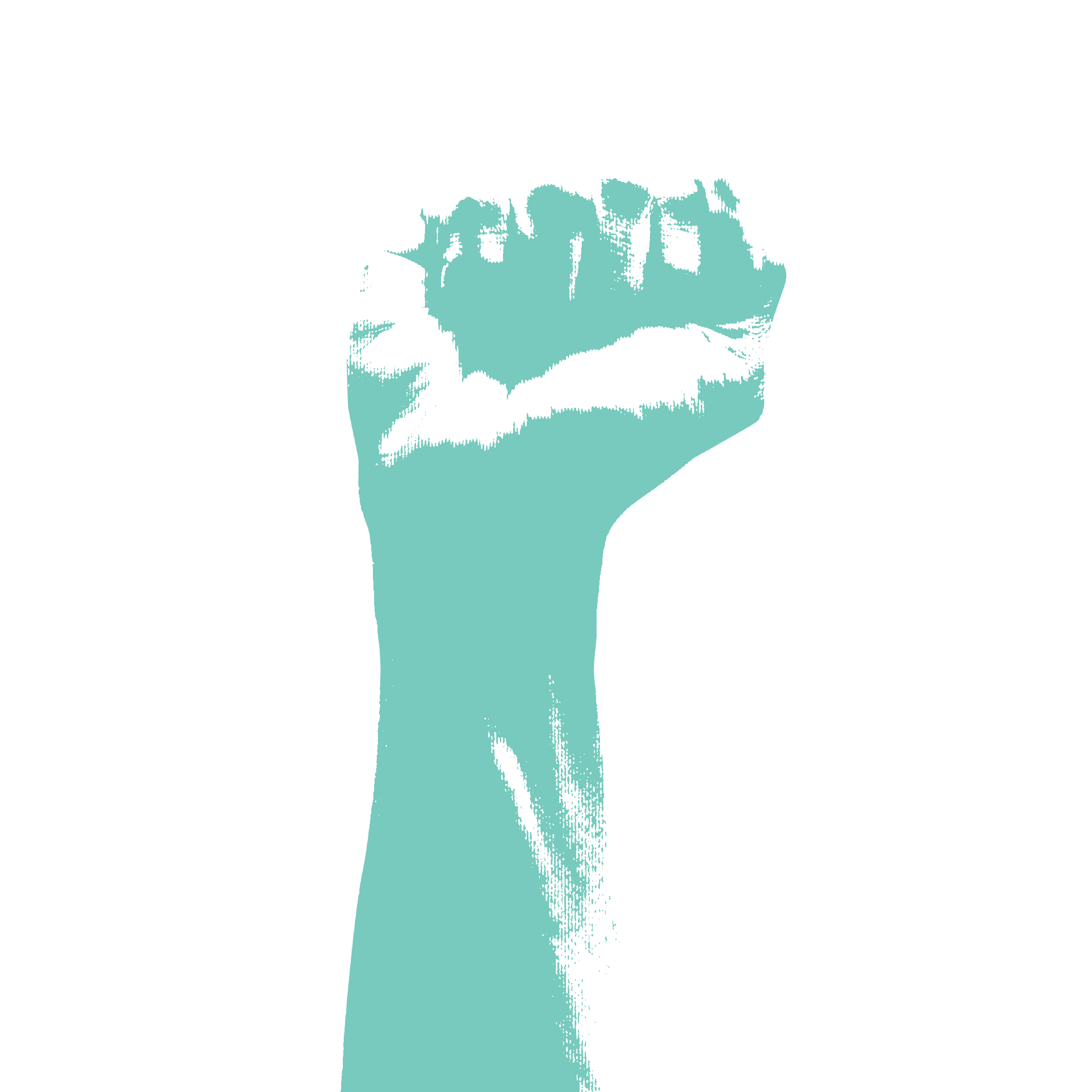This unit was created by Jacqueem Winston, a high school Social Studies educator in Plainfield, New Jersey, as part of the 2022-2023 Pulitzer Center Teacher Fellowship program. It is designed for facilitation across nine 45–90-minute class periods over the course four weeks, with work outside of class.
For more units created by Pulitzer Center Teacher Fellows in this cohort, click here.
Objectives:
Students will be able to...
- Understand redlining, gentrification, environmental racism, inaccessibility of housing, and other geography-related challenges experienced by Black Americans
- Conduct sustained research in order to answer a research question
- Integrate relevant information from multiple authoritative digital sources into an essay
- Create a faux social media post based on research
Unit Overview:
This unit focuses on guiding students to think critically about how global problems are also affecting their local communities and how systemic global issues also connect to issues they see in their communities. Through analysis of those connections, the unit inspires them to report on issues from their communities and to consider how reporting on their communities might also inspire connections to communities throughout the world. Each student will have the opportunity to look at underreported stories from around the globe. After reading and evaluating these news reports, students will then flip that journalism on its head by evaluating how the reporting they analyzed from another part of the world connects to issues they see in their communities. Next, they become the reporter. They will have the chance to find a local underreported story and report on it after receiving guidance from a Pulitzer Center journalist. A unique twist to the final presentation is they will present their reporting in a multimedia fashion, such as a TikTok video or photo essay.
The ultimate goal is to answer the question, “How does my community relate to the larger global community in the problems that they face?” As students engage with this question, smaller thought-provoking questions also arise:
- What questions does a journalist need to ask to expand the public’s understanding of the root causes of an issue, and the many different stakeholders involved in an issue?
- How does what is happening in another part of the world impact my life?
- How do the underreported stories in my community connect to issues people are facing in other parts of the world?
All these questions are explored throughout the unit while students are also building media literacy skills, understanding how to format journalistic questions, and learning how to compose new underreported stories.
Performance Task:
Students will create a multimedia project to share an underreported story from their communities that connects to themes explored throughout the unit. This multimedia project could be a short TikTok video or a picture essay. The local report will reflect students’ research on an underreported issue in their communities and will include important skills, techniques and best practices that the Pulitzer Center journalists shared with the students during their visit. Ultimately, the goal is to understand how global underreported stories are similar to local issues and also deserve to be reported.
The Underreported Stories Project Description [.pdf] [.docx] outlines the project requirements, the evaluation rubric, and steps for planning the project.
Assessment/Evaluation:
1. Students will be assessed in numerous ways.
2. Exit ticket to concisely communicate main takeaways from some of the underreported news stories explored in class.
3. The annotation of the articles reviewed in class, and students’ responses to the following questions for each article:
- What have you already heard/know about the issue/ topic that they are looking at?
- What details stand out?
- Whose perspectives are presented and why?
- Whose perspectives are missing from this article?
- How does the story challenge assumptions about this issue?
- What new understanding do you have about the issue after reviewing the story?
- How do the themes/questions/perspectives presented in the story connect to you and your community?
- How would you present this information to someone else that may not know about this issue?
Each time a new article is introduced, students will answer all of these questions to become critical thinkers of the underreported stories.
4. Students will also be assessed on the questions that they create for the journalist who presents during the live interview session.
5. Students will be assessed on their multimedia project using the rubric outlined on page of the Underreported Stories Project Description [.pdf] [.docx]
6. Finally, students will be assessed on the reflection (short questionnaire) that they complete at the end of the entire unit.
Nine-lesson unit plan for teachers, including pacing, texts and multimedia resources, guiding questions for group discussions, and performance task instructions and grading rubric for the unit.
Unit Resources:
New Jersey State Learning Standards - Social Studies:
Lead Standard:
NJ 6.1.12.HistorySE.14.b: Use a variety of sources from diverse perspectives to analyze the social, economic and political contributions of marginalized and underrepresented groups and/or individuals.
Additional Standards Explored in this Unit:
NJ 6.1.12.HistoryCA.2.a: Research multiple perspectives to explain the struggle to create an American identity.
NJ 6.1.12.HistoryCA.3.b: Use primary sources representing multiple perspectives to explain the impact of immigration on American society and the economy and the various responses to increased immigration.
NJ 6.1.12.HistoryCC.4.b: Compare and contrast the impact of the American Civil War with the impact of a past or current civil war in another country in terms of the consequences of costs, reconstruction, people's lives, and work.
NJ 6.1.12.CivicsDP.5.a: Analyze the effectiveness of governmental policies and of actions by groups and individuals to address discrimination against new immigrants, Native Americans, and African Americans.
NJ 6.1.12.GeoHE.5.a: Generate/make an evidence-based argument regarding the impact of rapid urbanization on the environment and on the quality of life in cities.
NJ 6.1.12.EconEM.5.a: Analyze the economic practices of corporations and monopolies regarding the production and marketing of goods and determine the positive or negative impact of these practices on individuals and the nation and the need for government regulations.
NJ 6.1.12.HistoryUP.5.a: Using primary sources, relate varying immigrants’ experiences to gender, race, ethnicity, or occupation.
NJ 6.1.12.CivicsDP.6.a: Use a variety of sources from multiple perspectives to document the ways in which women organized to promote government policies designed to address injustice, inequality, and workplace safety.
NJ 6.1.12.GeoHE.6.a: Compare and contrast issues involved in the struggle between the unregulated development of natural resources and efforts to conserve and protect natural resources during the period of industrial expansion. (even though this is a 1890’s standard)
NJ 6.1.12.GeoGM.6.a: Determine the role geography played in gaining access to raw materials and finding new global markets to promote trade.
NJ 6.1.12.HistoryCA.6.a: Evaluate the effectiveness of labor and agricultural organizations in improving economic opportunities and rights for various groups.
NJ 6.1.12.GeoHE.8.a: Determine the impact of the expansion of agricultural production into marginal farmlands and other ineffective agricultural practices on people and the environment.
NJ 6.1.12.HistoryCC.11.a: Assess the impact of the arms race and the proliferation of nuclear weapons on world power, security, and national foreign policy.
NJ 6.1.12.HistoryCC.11.c: Explain why women, African Americans, Native Americans, Asian Americans, and other minority groups often expressed a strong sense of nationalism despite the
discrimination they experienced in the military and workforce.
NJ 6.1.12.EconNE.12.a: Assess the impact of agricultural innovation on the world economy.
NJ 6.1.12.GeoHE.13.a: Construct an argument on the effectiveness of environmental movements, their influence on public attitudes, and the efficacy of the government’s environmental protection agencies and laws.
NJ 6.1.12.EconEM.13.a: Explain how individuals and organizations used economic measures as weapons in the struggle for civil and human rights.
NJ 6.1.12.HistorySE.13.a: Use a variety of sources to explain the relationship between the changing role of women in the labor force and changes in family structure.
NJ 6.1.12.CivicsPI.14.d: Use primary sources representing multiple perspectives and data to determine the effectiveness of the federal government in addressing health care, income equality, and immigration.
NJ 6.1.12.CivicsPD.14.a: Draw from multiple perspectives and cite evidence to explain the conflicting ideologies and actions of political parties regarding spending priorities, the role of government in the economy, and social reforms.
NJ 6.1.12.GeoPP.14.a: Use data and other evidence to determine the impact of recent immigration and migration patterns in New Jersey and the United States on demographic, social, economic, and political issues.
NJ 6.1.12.GeoPP.14.b: Use evidence to document how regionalization, urbanization, and suburbanization have led to social and economic reform movements in New Jersey and the United States.
NJ 6.1.12.GeoHE.14.a: Evaluate the impact of individual, business, and government decisions and actions on the environment and climate change and assess the efficacy of government policies and agencies in New Jersey and the United States in addressing these decisions.
NJ 6.1.12.EconET.14.a: Use current events to judge what extent the government should intervene at the local, state, and national levels on issues related to the economy.
NJ 6.1.12.HistorySE.14.a: Explore the various ways women, racial and ethnic minorities, the LGBTQ community, and individuals with disabilities have contributed to the American economy, politics and society.
NJ 6.1.12.HistoryCC.15.c: Evaluate the effectiveness of United States policies and actions in supporting the economic and democratic growth of developing nations.
NJ 6.1.12.HistoryUP.16.a: Analyze the impact of American culture on other world cultures and determine the impact of social media on the dissemination of American culture.
NJ 6.1.12.HistoryCC.16.a: Assess from various perspectives the effectiveness with which the United States government addresses economic issues that affect individuals, business, and/or other countries.
The following are examples from students in Plainfield, New Jersey, who engaged with this unit in spring 2023.
1. Students start the unit by reviewing the term "underreported story" and considering the issues they think are underreported. They then explored the story “How Thailand Pushes Myanmar Migrants Into Modern Slavery” by Kiana Duncan for Deutsche Welle.
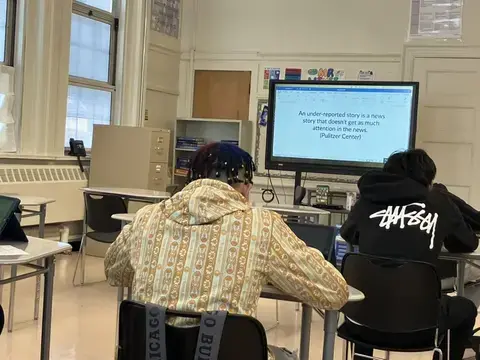
2. Students continued their exploration of the questions that guide underreported stories by identifying stories to explore in small groups and then connecting with a Pulitzer Center grantee Lexi Parra to learn more about the process of identifying and researching underreported stories.
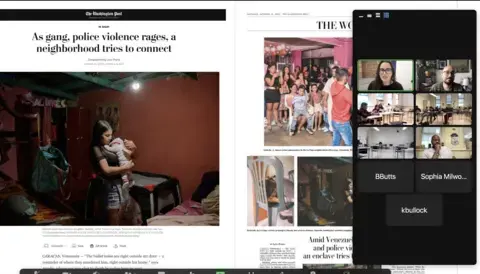
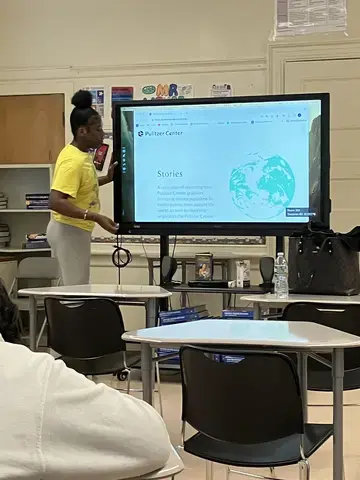
3. By the end of the unit, students identified their own research projects and created presentations about research into underreported issues in their own communities. Students reported on immigration, local politics, business, health, and crime.
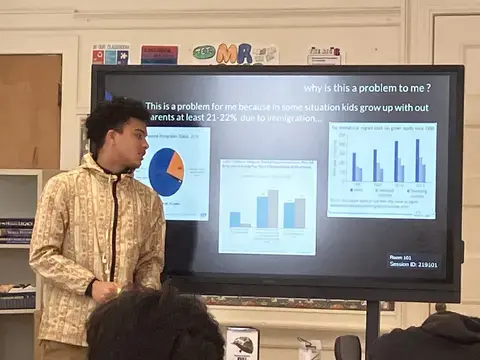
4. The unit ends with a survey for students. In spring 2023, students in Plainfield, NJ shared the following when asked what stood out to them from the unit:
